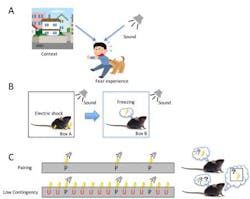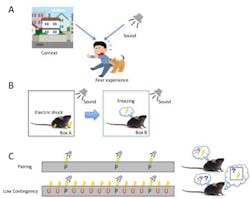Optogenetics helps untangle ambiguity in neural circuits
Learning how to predict dangerous relationships in the environment—such as between odors and food, lightning and thunder, or sounds and predators—is essential for survival. While much is known about how experiences become linked with unpleasant outcomes when the associations are clear, how these links are updated in the brain when the relationships are ambiguous was unknown.
In a new study, a team of scientists at the RIKEN Brain Science Institute (Wako City, Japan) and New York University (NYU) reports that ambiguity in these types of associations can be observed in rats that had previously learned a tone-shock association and were then given shocks without the tone. Using optogenetics—a technique to control brain cell activity with bursts of light—the researchers found traces of both the memory and its associated uncertainty stored in neural circuits of a central brain area called the amygdala.
Related: Optogenetics studies the fly olfactory system to understand neural circuits
When given shocks after hearing a tone, rats that have learned the association normally freeze, anticipating the shock. However, when the same animals learned that shocks could also arrive without a tone, they showed less anticipatory freezing because the causal link between tone and shock was not clear. In the brain, this uncertainty was reflected in reduced strength of neural connections between the auditory system (where tones are processed) and the amygdala, a brain region critical for storing unpleasant memories. Strong connections that formed after learning the tone-shock association were reversible if the relationship later became ambiguous.
By manipulating brain activity with optogenetics, the researchers showed that specific neurons in the amygdala were responsible for enabling the uncertainty. When those neurons were silenced as animals experienced shocks without a preceding tone, surprisingly, rather than acting unsure and freezing less often, the animals always acted as if they expected to be shocked when they heard the tone. This indicated that the amygdala not only stores unpleasant memories, but also plays an active role in an animal's evaluation of the associated level of ambiguity.
The research team also mathematically analyzed how rats responded when different patterns of lights, tones, and shocks unfolded in their environment under ambiguous conditions. A longstanding theory suggested that different sensory cues in the environment compete for association with outcomes such as food or threats, resulting in one association winning out. Contradicting this theory, the team found that the way rats evaluate ambiguity can be best described with a dynamic model that considers several different configurations of how tones, lights, or other features of the environment might interact during learning. Their results suggest that humans may also evaluate their environment and its events using a statistical approach that computes the probabilities of associations to estimate ambiguity.
The findings may also have implications for understanding diseases involving ambiguous associations such as anxiety, and in the design of more flexible computer architectures.
Full details of the work appear in the journal Nature Neuroscience; for more information, please visit http://dx.doi.org/10.1038/nn.4308.

